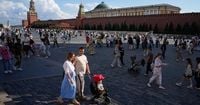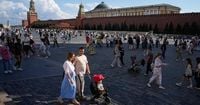Russia is facing a stark demographic crossroads. After a quarter-century of efforts led by President Vladimir Putin, the country’s population is shrinking and aging at a pace not seen in generations. Despite a raft of incentives, new laws, and symbolic gestures, the number of babies born in Russia continues to fall, while the population grows older and the nation’s future becomes ever more uncertain.
At a Kremlin demographic conference on October 23, 2025, Putin did not mince words about the scale of the challenge. He called boosting births “crucial” for the nation’s future, underscoring a problem that has haunted his tenure since he took office in 2000. According to the Associated Press, Putin said, “Many of our grandmothers and great-grandmothers had seven, eight, and even more children. Let’s preserve and revive these wonderful traditions. Having many children and a large family must become the norm.”
The numbers tell a sobering story. In 1999, just before Putin assumed power, births in Russia hit a record low of 1.21 million. Over the next decade and a half, an improving economy helped push that figure up to nearly 1.94 million in 2015. But those gains have since evaporated. The war in Ukraine, economic turbulence, and a wave of emigration have sent births tumbling once again. In 2024, only 1.22 million babies were born—barely above the 1999 nadir. Demographer Alexei Raksha reported that February 2025 saw the lowest monthly birth figure in Russia in more than two centuries, according to BSS.
Russia’s population has dropped from 147.6 million in 1990 to about 146.1 million in 2025, a figure that includes Crimea’s population after its illegal 2014 annexation. The aging trend is even more dramatic: 30% of Russians are now 55 or older, compared to just 21.1% in 1990, as reported by Russia’s Federal Statistics Service. Deaths now outpace births, and the pool of young adults—the nation’s future parents—has shrunk alarmingly.
This demographic squeeze is compounded by Russia’s harsh history. The devastating loss of 27 million Soviet citizens in World War II left a lasting scar on the population. The collapse of the Soviet Union brought further turmoil, and now, the ongoing war in Ukraine has siphoned off hundreds of thousands of young men, either as casualties or in a new wave of emigration. “You’ve got a much-diminished pool of potential fathers in a diminished pool of potential mothers,” analyst Jenny Mathers told the Associated Press. For Putin, who has long tied population strength to national security, this is a particularly acute concern.
In response, the Kremlin has doubled down on what it calls “traditional family values.” Over the years, Putin’s government has introduced a mix of incentives and restrictions aimed at boosting births. These include free school meals for large families, cash certificates for parents that can be used for pensions, education, or subsidized mortgages, and the reinstatement of Soviet-style “hero-mother” medals for women who raise at least 10 children. Some regions have offered one-time payments to pregnant teenagers—about $1,200 in some cases—though these policies have sparked debate about their effectiveness and ethics.
Symbolic gestures have also proliferated. Since 2022, Russia has celebrated Family, Love and Fidelity Day in July and Pregnant Women’s Day on April 7 and October 7, according to AP. These holidays, along with new state-sponsored campaigns, are meant to encourage Russians to embrace larger families. However, the country’s fertility rate remains stubbornly low at 1.4 children per woman, well below the replacement rate of 2.1. For comparison, the U.S. fertility rate was 1.6 in 2024, the Centers for Disease Control and Prevention reported.
But the Kremlin’s push for bigger families has come with a sharp conservative turn. Laws now ban the promotion of abortion and so-called “child-free ideology,” and a sweeping crackdown on LGBTQ+ rights has taken hold. The wording of these laws is often vague, leaving them open to broad interpretation and, critics say, repression. “Officials see these values as a ‘magic wand’ for solving demographic problems,” argued feminist scholar Sasha Talaver in BSS. In her view, the state expects women to bear children “in the name of patriotism and Russian strength.”
Access to abortion has become increasingly restricted. Private clinics have stopped offering the procedure, abortion pills have become harder to obtain, and mandatory waiting periods have lengthened. Some regions have made it illegal to “encourage abortions,” and national legislation in 2024 banned the promotion of “child-free propaganda.” Women are now encouraged—or sometimes compelled—to seek abortions only at state clinics, where waits are longer and the process more cumbersome. “The only thing you will get from this is illegal abortions. That means more deaths: more children’s deaths and more women’s deaths,” warned journalist and activist Zalina Marshenkulova in an interview with the Associated Press. She sees the government’s restrictions as “repression for repression’s sake.”
Meanwhile, immigration, which could help offset population decline, is also being curtailed. The Kremlin has tightened controls and stoked anti-migrant sentiment, discouraging workers from Central Asia who have long filled gaps in Russia’s labor market. Recent crackdowns have tracked migrants’ movements, impeded their children’s access to education, and limited employment opportunities. Central Asians are now looking elsewhere for work, wary of growing discrimination and economic instability.
For many Russians, the uncertainty of wartime life overshadows any government incentives. “When people lack confidence about their prospects, it’s not a time for having children,” Mathers explained to BSS. “An open-ended major war doesn’t really encourage people to think positively about the future.” This sentiment is echoed by a 29-year-old Moscow woman who chose to remain child-free. “The happiest and healthiest child will only be born in a family with healthy, happy parents,” she told AP, emphasizing the importance of stability over state pressure.
Despite the government’s best efforts, the core challenge remains: no law or incentive can easily reverse the effects of economic anxiety, war, and a shrinking base of young adults. As Russia marks another year of demographic decline, the question looms: can any policy truly turn the tide, or is the nation destined to grow smaller and older in the decades to come?

